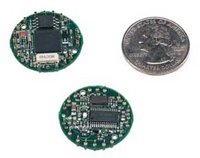There are thousands of different ways that motes might be used, and as people get familiar with the concept they come up with even more. It is a completely new paradigm for distributed sensing and it is opening up a fascinating new way to look at computers.
The Basic Idea
 The "mote" concept creates a new way of thinking about computers, but the basic idea is pretty simple:
The "mote" concept creates a new way of thinking about computers, but the basic idea is pretty simple:The core of a mote is a small, low-cost, low-power computer.
The computer monitors one or more sensors. It is easy to imagine all sorts of sensors, including sensors for temperature, light, sound, position, acceleration, vibration, stress, weight, pressure, humidity, etc. Not all mote applications require sensors, but sensing applications are very common.
The computer connects to the outside world with a radio link. The most common radio links allow a mote to transmit at a distance of something like 10 to 200 feet (3 to 61 meters). Power consumption, size and cost are the barriers to longer distances. Since a fundamental concept with motes is tiny size (and associated tiny cost), small and low-power radios are normal.
Motes can either run off of batteries, or they can tap into the power grid in certain applications. As motes shrink in size and power consumption, it is possible to imagine solar power or even something exotic like vibration power to keep them running.
All of these parts are packaged together in the smallest container possible. In the future, people imagine shrinking motes to fit into something just a few millimeters on a side. It is more common for motes today, including batteries and antenna, to be the size of a stack of five or six quarters, or the size of a pack of cigarettes. The battery is usually the biggest part of the package right now. Current motes, in bulk, might cost something on the order of $25, but prices are falling.
It is hard to imagine something as small and innocuous as a mote sparking a revolution, but that's exactly what they have done. We'll look at a number of possible applications in the next section.
How Motes Work
It is possible to think of motes as lone sensors. For example:
You could embed motes in bridges when you pour the concrete. The mote could have a sensor on it that can detect the salt concentration within the concrete. Then once a month you could drive a truck over the bridge that sends a powerful magnetic field into the bridge. The magnetic field would allow the motes, which are burried within the concrete of the bridge, to power on and transmit the salt concentration. Salt (perhaps from deicing or ocean spray) weakens concrete and corrodes the steel rebar that strengthens the concrete. Salt sensors would let bridge maintenance personnel gauge how much damage salt is doing. Other possible sensors embedded into the concrete of a bridge might detect vibration, stress, temperature swings, cracking, etc., all of which would help maintenance personnel spot problems long before they become critical.
lot of ideas we can apply However, much of the greatest excitement about motes comes from the idea of using large numbers of motes that communicate with each other and form ad hoc network
Ad hoc Networks
The Defense Advanced Research Projects Agency (DARPA) was among the original patrons of the mote idea. One of the initial mote ideas implemented for DARPA allows motes to sense battlefield conditions.
For example, imagine that a commander wants to be able to detect truck movement in a remote area. An airplane flies over the area and scatters thousands of motes, each one equipped with a magnetometer, a vibration sensor and a GPS receiver. The battery-operated motes are dropped at a density of one every 100 feet (30 meters) or so. Each mote wakes up, senses its position and then sends out a radio signal to find its neighbors.
All of the motes in the area create a giant, amorphous network that can collect data. Data funnels through the network and arrives at a collection node, which has a powerful radio able to transmit a signal many miles. When an enemy truck drives through the area, the motes that detect it transmit their location and their sensor readings. Neighboring motes pick up the transmissions and forward them to their neighbors and so on, until the signals arrive at the collection node and are transmitted to the commander. The commander can now display the data on a screen and see, in real time, the path that the truck is following through the field of motes. Then a remotely-piloted vehicle can fly over the truck, make sure it belongs to the enemy and drop a bomb to destroy it.
This concept of ad hoc networks -- formed by hundreds or thousands of motes that communicate with each other and pass data along from one to another -- is extremely powerful.
No comments:
Post a Comment